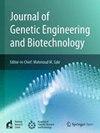马齿苋种子的植物化学筛选,抗氧化和抗菌分析与硅分子对接见解
IF 3.5
Q3 Biochemistry, Genetics and Molecular Biology
Journal of Genetic Engineering and Biotechnology
Pub Date : 2025-06-18
DOI:10.1016/j.jgeb.2025.100516
引用次数: 0
摘要
马齿苋(porulaca oleracea, PO)是一种分布于全球的一年生多肉草本植物,自古以来就被用作药用,素有“全球万灵药”的称号。目的对番石榴种子进行植物化学筛选、抗氧化和抗菌分析,包括甲醇提取物的GCMS分析和抗菌机制的分子对接。材料和方法对spo种子进行植物化学筛选,并通过DPPH、NO自由基清除和还原能力分析甲醇提取物。对细菌和真菌进行了抑菌活性测试,用GCMS鉴定了化合物。通过Autodock进行分子对接,靶向β -微管蛋白(5FNV)和ABC转运蛋白(6J9W)。结果甲醇提取物具有较强的抗氧化活性(IC50:对DPPH 125.2µg/ml,对NO 402.89µg/ml)和浓度依赖性还原能力。对酿酒酵母菌和降毒弧菌有较好的抑菌效果。GCMS鉴定出秋水仙碱、正癸酸和三环氧癸烷,其中秋水仙碱对蛋白质靶点具有较高的结合亲和力。结论秋水仙碱的结合亲和性支持了甲醇提取物的抗氧化和抗菌作用,证实了其药用潜力,值得进一步探索。本文章由计算机程序翻译,如有差异,请以英文原文为准。
Phytochemical screening, antioxidant, and antimicrobial analysis of Portulaca oleracea seeds with in-silico molecular docking insights
Background
Portulaca oleracea (PO), an annual succulent herb with global distribution, has been used medicinally since ancient times, earning the title “global panacea.”
Aim
This study aimed to perform phytochemical screening, antioxidant and antimicrobial analysis of PO seeds, including GCMS analysis of methanolic extract and molecular docking for antimicrobial mechanisms.
Materials and Methods
PO seeds underwent phytochemical screening and methanolic extract analysis via DPPH, NO radical scavenging, and reducing power assays. Antimicrobial activity was tested against bacteria and fungi, with GCMS identifying compounds. Molecular docking was conducted via Autodock vina, against targets beta-tubulin (5FNV) and ABC transporter (6J9W).
Results
Methanolic extract showed strong antioxidant activity (IC50: 125.2 µg/ml for DPPH, 402.89 µg/ml for NO) and concentration-dependent reducing power. It was highly effective against Saccharomyces cerevisiae and Hypochrea viridescens. GCMS identified colchicine, n-decanoic acid, and triepoxydecane, with colchicine showing high binding affinity to protein targets.
Conclusion
The methanolic extract’s potent antioxidant and antimicrobial effects, supported by colchicine’s binding affinity, validate PO’s medicinal potential, suggesting further therapeutic exploration.
求助全文
通过发布文献求助,成功后即可免费获取论文全文。
去求助
来源期刊

Journal of Genetic Engineering and Biotechnology
Biochemistry, Genetics and Molecular Biology-Biotechnology
CiteScore
5.70
自引率
5.70%
发文量
159
审稿时长
16 weeks
期刊介绍:
Journal of genetic engineering and biotechnology is devoted to rapid publication of full-length research papers that leads to significant contribution in advancing knowledge in genetic engineering and biotechnology and provide novel perspectives in this research area. JGEB includes all major themes related to genetic engineering and recombinant DNA. The area of interest of JGEB includes but not restricted to: •Plant genetics •Animal genetics •Bacterial enzymes •Agricultural Biotechnology, •Biochemistry, •Biophysics, •Bioinformatics, •Environmental Biotechnology, •Industrial Biotechnology, •Microbial biotechnology, •Medical Biotechnology, •Bioenergy, Biosafety, •Biosecurity, •Bioethics, •GMOS, •Genomic, •Proteomic JGEB accepts
 求助内容:
求助内容: 应助结果提醒方式:
应助结果提醒方式:


